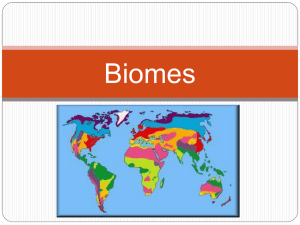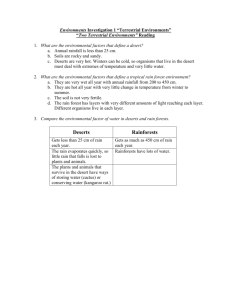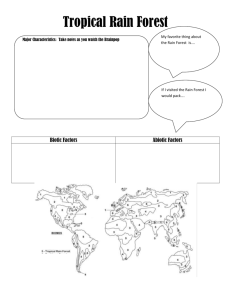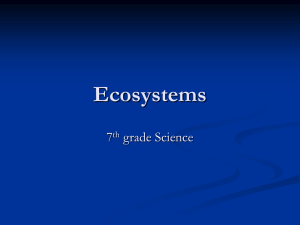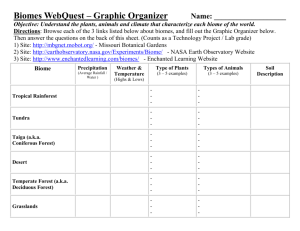Ch22Sec4 - Stephanie Dietterle Webpage
advertisement
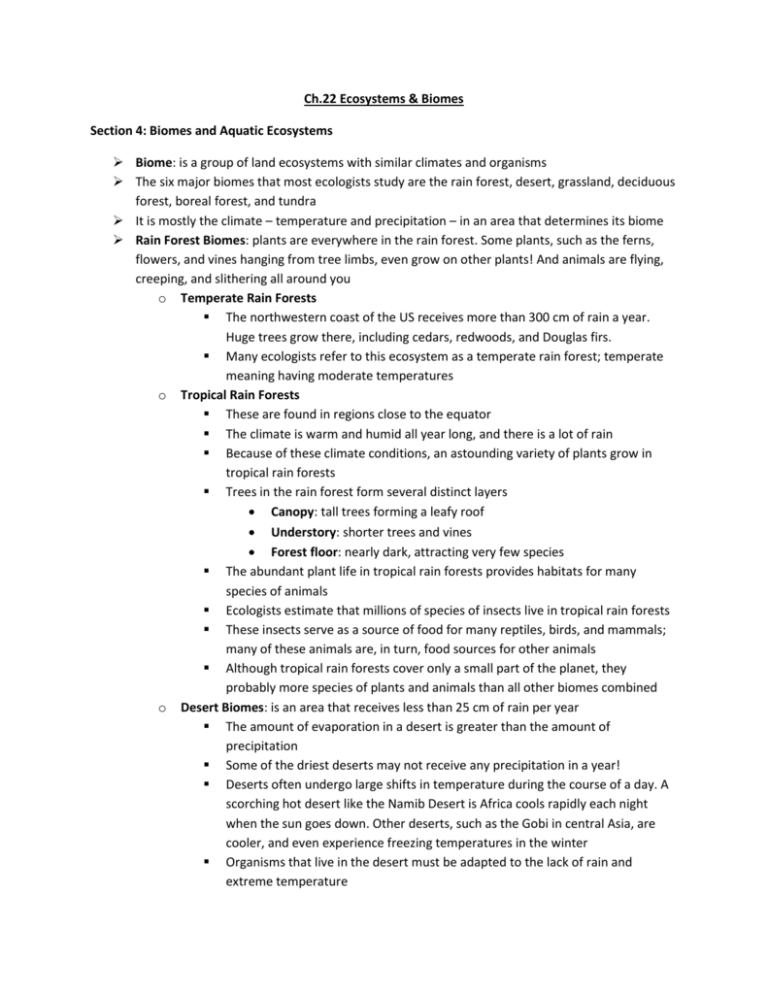
Ch.22 Ecosystems & Biomes Section 4: Biomes and Aquatic Ecosystems Biome: is a group of land ecosystems with similar climates and organisms The six major biomes that most ecologists study are the rain forest, desert, grassland, deciduous forest, boreal forest, and tundra It is mostly the climate – temperature and precipitation – in an area that determines its biome Rain Forest Biomes: plants are everywhere in the rain forest. Some plants, such as the ferns, flowers, and vines hanging from tree limbs, even grow on other plants! And animals are flying, creeping, and slithering all around you o Temperate Rain Forests The northwestern coast of the US receives more than 300 cm of rain a year. Huge trees grow there, including cedars, redwoods, and Douglas firs. Many ecologists refer to this ecosystem as a temperate rain forest; temperate meaning having moderate temperatures o Tropical Rain Forests These are found in regions close to the equator The climate is warm and humid all year long, and there is a lot of rain Because of these climate conditions, an astounding variety of plants grow in tropical rain forests Trees in the rain forest form several distinct layers Canopy: tall trees forming a leafy roof Understory: shorter trees and vines Forest floor: nearly dark, attracting very few species The abundant plant life in tropical rain forests provides habitats for many species of animals Ecologists estimate that millions of species of insects live in tropical rain forests These insects serve as a source of food for many reptiles, birds, and mammals; many of these animals are, in turn, food sources for other animals Although tropical rain forests cover only a small part of the planet, they probably more species of plants and animals than all other biomes combined o Desert Biomes: is an area that receives less than 25 cm of rain per year The amount of evaporation in a desert is greater than the amount of precipitation Some of the driest deserts may not receive any precipitation in a year! Deserts often undergo large shifts in temperature during the course of a day. A scorching hot desert like the Namib Desert is Africa cools rapidly each night when the sun goes down. Other deserts, such as the Gobi in central Asia, are cooler, and even experience freezing temperatures in the winter Organisms that live in the desert must be adapted to the lack of rain and extreme temperature Example: the stem of a saguaro cactus has folds that work like the pleats in an accordion. The stem expands to store water when it is raining. Gila monsters can spend weeks at a time in their cool underground burrows. Many other desert animals are most active at night when the temperatures are cooler Grassland Biomes: is an area that is populated mostly by grasses and other non-woody plants o Although this prairie receives more rain than a desert, it does not get enough rain for trees to grow o Most grasslands receive 25-75 cm of rain each year o Fires & droughts are common in this biome o Savanna: this grassland is located closer to the equator Receives 120 cm of rain each year o Grasslands are home to many of the largest animals on Earth – herbivores such as elephants, bison, antelopes, zebras, rhinoceroses, giraffes, and kangaroos Deciduous Forest Biomes: trees that shed their leaves and grow new ones each year o Examples: oaks & maples (trees) o Deciduous forests receive enough rain to support the growth of trees and other plants, at least 50 cm per year o Temperatures in the deciduous forest vary greatly during the year; the growing season usually lasts five to six months o During winter months in the deciduous forest most of the organisms migrate, or hibernate Boreal Forest Biomes (Taiga) o Boreal Forest Plants Coniferous tress: trees that produce their seeds in cones and have leaves shaped like needles Snow can reach heights well over your head! Tree species in the boreal forest as well-adapted to the cold climate; since water is frozen for much of the year, trees in boreal forest must have adaptations that prevent water loss o Boreal Forest Animals Eat the seeds produced by the coniferous trees Animals include: red squirrels, insects, and birds such as finches and chickadees Herbivores: snowshoe hares, moose, & beavers Predators: wolves, bears, great horned owls, & lynxes Tundra Biomes: is an extremely cold and dry biome o Permafrost: frozen soil Because rainwater cannot soak into the permafrost, there are many shallow ponds and marshy areas on the tundra in the summer o Tundra Plants Include: mosses, grasses, shrubs, & dwarf forms of a few trees, such as willows Most of the plant growth takes place during the long days of the short summer season North of the Arctic Circle, the sun does not set during midsummer o Tundra Animals Include: insect-eating birds, caribou, foxes, wolves, & Arctic hares The mammals that remain on the Tundra during the winter grow thick fur coats Mountains & Ice o These are not part of any major biomes because they are covered with thick sheets of ice o Island of Greenland & the continent of Antarctica o Organisms that are adapted to life on ice include emperor penguins, polar bears, and leopard seals Freshwater Ecosystems: include streams, rivers, ponds, & lakes o Streams & Rivers Trout have streamline bodies that allow them to swim despite fast-moving water Few plants or algae can grow in this fast-moving water; instead, first-level consumers rely on leaves and seeds that fall into the stream As the stream moves along other streams join it slowing the current making it become cloudy with soil This warmer slower-moving water has less oxygen an may be called a river There are many different organisms now that can adapt to the river Plants take root Provide food for young insects & homes for frogs & their tadpoles o Ponds & Lakes: bodies of standing, or still, fresh water Ponds are often shallow enough that sunlight can reach the bottom even in the center of the pond, allowing plants to grow there Many animals are adapted for life in the still water: dragonflies, turtles, snails, frogs, sunfish, insects, catfish, bacteria, and other decomposers feed on the remains of other organisms Marine Ecosystems: include estuaries, intertidal zones, neritic zones, and the open ocean o Estuary: is found where the fresh water of a river meets the salt water of the ocean Algae and plants such as marsh grasses provide food and shelter for numerous animals including crabs, worms, clams, and fish Many animals use the calm waters of estuaries for breeding grounds o Intertidal Zone: between the highest high-tide line and the lowest low-tide line Organisms here must be able to survive pounding waves and sudden changes in water levels and temperature that occur with high and low tides o o Animals such as barnacles and sea stars cling to the rock. Others, such as clams & crabs, burrow in the sand Neritic Zone: below the low-tide line is a region of shallow water, which extends over the continental shelf Because sunlight passes through the shallow water of the neritic zone, photosynthesis can occur As a result, this zone is particularly rich in living things Many large schools of fish, such as sardines, feed on algae In warm oceans waters, coral reefs many form; these provide living homes to a wide variety of other organisms The Open Ocean: also known as the “surface zone” Many marine animals depend on the algae for food The deep zone is located below the surface zone an almost totally dark Most animals in this zone feed on the remains of organisms that sink down from the surface zone The deepest parts of the deep zone are home to bizarre-looking animals, such as giant squid whose eyes glow in the dark
